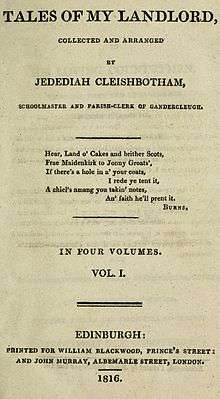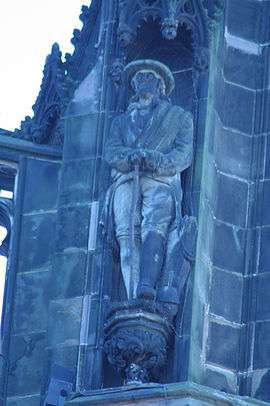Old Mortality
 First edition title page | |
| Author | Sir Walter Scott |
|---|---|
| Country | Scotland |
| Language | English, Lowland Scots |
| Series | Tales of My Landlord (1st series) |
| Genre | Historical novel |
Publication date | 1816 |
| Media type | Print (Hardback & Paperback) |
| ISBN | 978-0-19-955530-7 |

Old Mortality is a novel by Sir Walter Scott set in the period 1679–89 in south west Scotland. It forms, along with The Black Dwarf, the 1st series of Scott's Tales of My Landlord. The two novels were published together in 1816. Old Mortality is considered one of Scott's best novels.
It was originally titled The Tale of Old Mortality, but is generally shortened in most references.
Plot summary
After an Introduction to the Tales of My Landlord, supposedly written by the novel's (fictional) editor Jedediah Cleishbotham, an introduction by the author describes Robert Paterson, a Scotsman of the 18th century, who late in life decided to travel around Scotland re-engraving the tombs of 17th century Covenanter martyrs, and who Scott met at Dunottar. In the first chapter of the novel Cleishbotham describes at length meeting Paterson, hearing his anecdotes, and finding other stories of the events to present an unbiased picture.
The novel then describes a wapenshaw held in 1679 by Lady Margaret Bellenden, life-rentrix of the barony of Tillietudlem. This was a show of her support for the Royalist cause, but most of her tenants favoured the opposing Covenanters (who wanted the re-establishment of presbyterianism in Scotland) and she has to enlist her unwilling servants. After her supporters are duly mustered, the main sport is a shoot at the popinjay in which the Cavalier favourite is narrowly defeated by Henry Morton, son of a Covenanter. He is introduced to Lady Margaret and her lovely granddaughter Edith Bellenden.
During celebrations of his popinjay victory in the inn that evening, Morton stands up for John Balfour of Burley against bullying by Cavalier dragoons. That night, Burley turns up uninvited at Morton's house and demands shelter. Morton reluctantly agrees, and it emerges that Burley was one of the assassins of Archbishop James Sharp. In the morning they have to flee Cavalier patrols. As a consequence, Morton finds himself outlawed, and joins Burley in the uprising at the Battle of Drumclog, at which group of around 200 armed Covenanters moved east, to a boggy moor near the farm of Drumclog. With about 40 mounted men, and armed with muskets and pitchforks, the Covenanter force was no rabble, and eventually charges round the edge of a bog or 'stank', routing the dragoons from the battlefield and leaving 36 dead. However, after this initial success, Scott traces the growth of factionalism, which hastened its defeat at the Battle of Bothwell Bridge in 1679, by forces led by the Duke of Monmouth and John Graham of Claverhouse.
Henry Morton's involvement in the rebellion causes a conflict of loyalties for him, since he is in love with Edith Bellenden, who belongs to a Royalist family who oppose the uprising. Henry's beliefs are not as extreme as those of Burley and many other rebel leaders, which leads to his involvement in the factional disputes. The novel also shows their oppressors, led by Claverhouse, to be extreme in their beliefs and methods. Comic relief is provided by Cuddie Headrigg, a peasant who reluctantly joins the rebellion because of his personal loyalty to Morton, as well as his own fanatical Covenanting mother, and acts as a manservant to Morton.
Following the defeat at Bothwell Bridge, Morton flees the battle field. He is soon captured by some of the extreme Covenanters, who see him as a traitor, and get ready to execute him. He is rescued by Claverhouse, who has been led to the scene by Cuddie Headrigg. Morton later witnesses the trial and torture of fellow rebels, before going into exile.
The novel ends with Morton returning to Scotland in 1689 to find a changed political and religious climate following the overthrow of James VII, and to be reconciled with Edith.
Main characters
- Henry Morton
- John Balfour of Burley
- Col. Graham of Claverhouse
- Cuddie Headrigg
- Mause Headrigg
- Lord Evandale
- Lady Margaret Bellenden of Tillietudlem Castle
- Miss Edith Bellenden
- Basil Olifant
- Inglis
- Sgt. Bothwell
- Cornet Richard Grahame
- Jenny Dennison
Adaptations and cultural references

The play Têtes rondes et Cavaliers (1833) by Jacques-François Ancelot and Joseph Xavier Saintine is based on Scott's novel.
Vincenzo Bellini's opera I puritani (1835), with a libretto written by Italian emigre in Paris, Count Carlo Pepoli, is in turn based on that play. It has become one of Bellini's major operas.